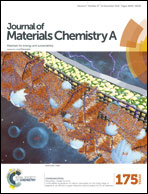Three-dimensional hierarchical nickel–cobalt–sulfide nanostructures for high performance electrochemical energy storage electrodes†
Abstract
To meet the ever-growing global demand for highly efficient and reliable energy storage systems, novel three-dimensional (3D) hierarchical porous cobalt–nickel–sulfide, H-(Co, Ni)3S2, nanostructures were designed and fabricated. The electrodes, based on a 3D hierarchical, porous nanoarchitecture, exhibit outstanding comprehensive performance with ultra-high specific capacitance of 4840 F g−1 (7.3 F cm−2) at current density of 1 A g−1, excellent rate capability of 3984 F g−1 (6.0 F cm−2) even at 20 A g−1, and superior cycling stability with as high as 93% capacitance retention after 5000 cycles at 10 A g−1. The performance greatly exceeds most previously reported faradaic electrodes for supercapacitors, due to the hierarchical, porous nanostructures, large active ion accessible surface area, varied and efficient faradic redox reactions, as well as strong mechanical stability and robust adhesion to the conductive matrix. Supercapacitors based on the 3D hierarchical H-(Co, Ni)3S2 nanostructured electrodes possess not only outstanding power and life performance, but also competitive energy densities, compared to the current, popular batteries.



 Please wait while we load your content...
Please wait while we load your content...